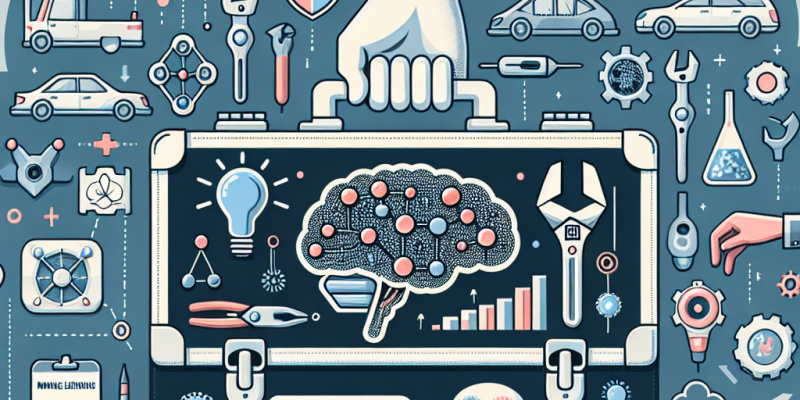The Machine Learning Toolkit: Harnessing New Algorithms for Real-World Problems

In the rapidly evolving landscape of technology, machine learning (ML) emerges as a transformative force, redefining possibilities across various domains. With its roots deeply embedded in artificial intelligence (AI), machine learning empowers systems to learn patterns and make predictions from data without being explicitly programmed. As industries grapple with complex challenges, the development and application of new algorithms within machine learning toolkits are becoming increasingly vital in driving innovative solutions to real-world problems.
Understanding Machine Learning and Its Applications
At its core, machine learning involves creating models that improve their performance on a specific task as they are exposed to more data. This fundamental characteristic enables applications across diverse fields, including healthcare, finance, agriculture, transportation, and more. For instance, ML algorithms are employed to predict disease outbreaks, optimize supply chains, assess credit risks, and enhance personalized marketing strategies.
The growing reliance on data-driven decision-making has led to an influx of new algorithms designed to process vast amounts of information efficiently. These algorithms enable systems to uncover hidden patterns, recognize trends, and provide insights that would otherwise remain obscured.
The Evolution of Machine Learning Algorithms
Historically, machine learning algorithms can be categorized into three primary types: supervised learning, unsupervised learning, and reinforcement learning. Each category equips practitioners with unique tools for specific problem domains:
-
Supervised Learning: Algorithms require labeled data to learn mappings between inputs and outputs. Common examples include regression models, decision trees, and support vector machines, which are frequently used for tasks such as classification and regression.
-
Unsupervised Learning: In this paradigm, algorithms seek to identify patterns in unlabeled data. Techniques such as clustering, dimensionality reduction, and association rule learning play crucial roles in exploratory data analysis, anomaly detection, and market basket analysis.
- Reinforcement Learning: This approach enables agents to learn optimal strategies through trial and error in interactive environments. It has shown promise in robotics, game-playing, and autonomous systems, exemplified by notable advancements like AlphaGo.
Recent years have witnessed an explosion of new algorithms that have enhanced the capability of these frameworks. Techniques such as deep learning—a subset of machine learning that employs neural networks with many layers—have revolutionized fields such as computer vision, natural language processing, and generative modeling.
Key Toolkits and Their Impact
A comprehensive machine learning toolkit typically includes a collection of libraries, frameworks, and pre-built models designed to streamline the development process. Some of the most prominent toolkits include:
-
TensorFlow: Developed by Google, TensorFlow is an open-source library that allows developers to build and train deep learning models. Its user-friendly high-level API, Keras, simplifies the process of creating complex architectures, making it accessible to researchers and businesses alike.
-
PyTorch: Favored for its dynamic computation graph, PyTorch is an open-source ML library that supports advanced research and deep learning applications. It has become popular among academics and industry professionals for its flexibility and ease of use.
-
Scikit-Learn: This versatile library is designed for classical machine learning algorithms in Python. Scikit-Learn excels in providing simple and efficient tools for data mining, data analysis, and model evaluation, allowing users to quickly implement and experiment with different algorithms.
- XGBoost: Known for its exceptional performance in structured data tasks, XGBoost is an optimized implementation of gradient boosting that improves speed and model accuracy. It’s extensively used in competitions and real-world applications, particularly in classification tasks.
These toolkits enable data scientists and machine learning practitioners to focus on problem-solving rather than reinventing the wheel. By harnessing the power of state-of-the-art algorithms, organizations can derive actionable insights, automate processes, and create competitive advantages.
Addressing Real-World Problems with Algorithms
The intersection of complex data, innovative algorithms, and practical applications makes machine learning an essential component of modern problem-solving. Here are some real-world challenges being tackled through the deployment of ML algorithms:
-
Healthcare: Machine learning models are being utilized to predict patient outcomes, diagnose diseases based on medical images, and develop personalized treatment plans. Algorithms analyzing electronic health records can identify trends and enable proactive care.
-
Finance: Fraud detection systems harness machine learning algorithms to identify unusual patterns in transactional data, reducing the risk of losses. Additionally, algorithms predict stock prices, optimize investment portfolios, and assess creditworthiness in real-time.
-
Transportation: Autonomous vehicles rely heavily on machine learning for object detection, navigation, and route optimization. ML algorithms analyze real-time traffic patterns and reducing congestion while increasing safety and efficiency.
- Climate Change: Addressing climate change through predictive modeling and simulation is a rising focus area for machine learning. Algorithms forecast weather patterns, analyze ecological data, and optimize resource management to mitigate environmental impacts.
Challenges and Future Directions
Despite its potential, the deployment of machine learning algorithms faces several challenges, including data quality, bias, interpretability, and ethical considerations. As ML becomes more integrated into decision-making processes, the demand for transparency and accountability grows.
Going forward, the research community is actively focusing on advancing algorithms that can handle diverse and imperfect datasets, enhance model interpretability, and promote fairness in AI systems. The adaptation of ML practices across various industries will require collaboration between technologists, domain experts, and policymakers to ensure that these powerful tools are used responsibly.
Conclusion
The machine learning toolkit represents a dynamic array of algorithms, frameworks, and methodologies that empower organizations to tackle pressing real-world problems. As technology continues to evolve, so too will the algorithms and tools at our disposal. By harnessing these advances, practitioners can unlock new potentials, enhance productivity, and ultimately create a more efficient and equitable world. Machine learning stands not just as a technological advancement but as a cornerstone of innovation and progress.














